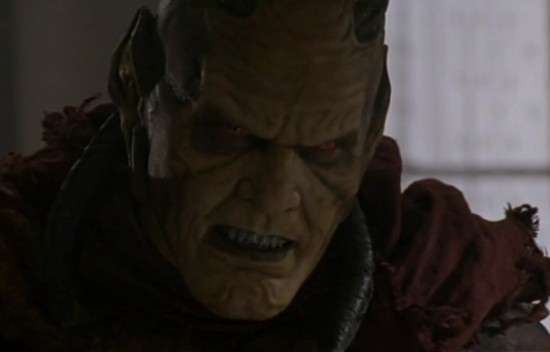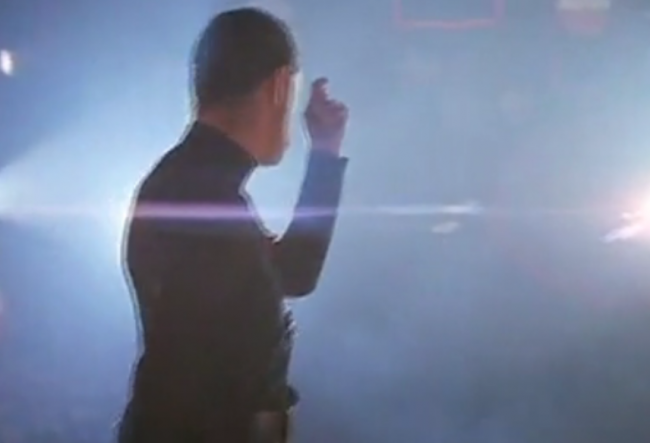31 Days of Horror: "Wishmaster 2"
by Sean McTiernan
In most genres the self-indulgence of actors is not something people usually enjoy, at least not intentionally. Sure, people have accidentally enjoyed I’m Still Here, perhaps mistaking it for a sketch where Zach Galifianakis is experiencing lengthy side effects from a surgery to make him taller. Mostly though, people like their actors to suffer. They have to lose weight (like Christian Bale in The Machinist), bulk up (like Christan Bale for Batman) or put a lot of work into inhabiting the mind of a disabled person (like Christian Bale on the set of Terminator Salvation).
But with horror villains, the opposite is true. The more a horror movie actor indulges himself and camps it up, the more horror nerds enjoy it. Some guys get the absurdity of this and are cool about it: Doug Bradley, who plays Pinhead, seems like a lovely man who both respects his character’s legacy but totally gets he’s not the world’s Most Important Thespian. Others tend to let it go to their head a bit: Robert Englund’s answer to an interview question put to him in 1989 about what Freddie represents is reportedly still going on and not expected to end until somewhere around December 2012.
And although camping it up has great value, you’ve got to do it right. Self-indulgence is good, but it takes an amount of skill to finesse it in a way that lets the audience share in it. That’s why Bruce Campbell and Jeffrey Combs are regarded rightly as genius splat practitioners, but also why a rating than zero had to be invented for Repo: The Genetic Opera. When it comes to doing it right, today’s movie features one of the great unsung examples of horror-movie scenery chewing.
You’ll probably recognise Andrew Divoff from his role as Mikhail Bakunin, the character responsible most of the best bits of “Lost.’ You might even recognise him from some of his many turns as Bad Guy Who Kills People in various TV shows. But the first two Wishmaster movies, especially the second, will always be his best performances for me. Because, although he always plays scumbags with glorious abandon, these two films are the ones in which he has the most fun.
The story in the Wishmaster movies is wholly unimportant. Andrew Divoff plays Djinn: a demon who, apart from wearing human skin, makes absolutely no attempt to hide the fact he is a demon. Both Wishmaster One and Two basically take the form of a series of vignettes where he dicks people over using his magical powers. You see, Djinn can do whatever he wants but technically has to use his power to fulfill someone’s wish (hence the title). So what we get to see is Djinn engaging unwitting victims in matches of syntax jousting until they finally to succumb to using the word “wish” in a sentence or even, it seems, expressing any sort of desire for anything. Djinn then swiftly twists the meaning of their words to kill them in uniformly gruesome ways reminiscent of any of the cheesier “Twilight Zone” twists. (Yes, eagle-eyed reader that is Kane Hodder, the most famous of the stuntmen to play Jason, in the role of unsuspecting, disgruntled security guard )
This would be great on its own, but Divoff’s performance takes it to the next level. The smary slime that drips off every syllable he puts out there disturbs not only the characters he deals with, but the actors. Most of these people are just trying to get through a low-budget movie they’d rather not be part of so it’s always great to see them slam up against the inimitably creepy brick wall that is Divoff’s gloriously grisly and serpentine performance. Even in musical theatre people usually can’t get this hammy without provoking homicidal rage in everyone involved. Divoff, though, captures the ridiculousness of the concept and the old-fashioned evil genie angle so perfectly with every evil stare and over pronunciation of the word “wishes” you can’t help but cheer him on.
Remarkably when you see Djinn in his real, supposedly more menacing form, it only serves as a disappointment compared to what Divoff has been doing up then with just two eyes, a controlled growl and a menacing row of pearly whites. A rubber suit can’t compare to practised creepiness.

The comparisons between the Wishmaster movies and Hellraiser are unavoidable. The antagonist is trapped in an ancient object, it’s all about the dangers of desiring too much and, of course, there’s the rubbery monster (in fairness to Wishmaster, the design of Djinn is far more HR Giger than Clive Barker). What’s so great about Wishmaster is it takes all the things Hellraiser fans hated about the movies from Hellraiser 3 on and completely revels in them.
Djinn swears like a modern day criminal, he kills people in the campiest way possible, there’s no real moral to what he does and he always-always-goes for the corniest joke possible. The first two Wishmaster movies replaces all the psychosexual leanings and pseudo-intellectual pomposity of the Hellraiser movies with a much sillier and humorous take while keeping the theatrical demonic protagonist and the themes of spearing people on their own desires. Not everyone looked at Hellraiser and thought “Man, this’d be great if it had way more puns and way less leather,” but I certainly revisit the adventures of Djinn more than the trials and tribulations of Pinhead.
I only recommended the second movie because, let’s face it, as much as you trust me I can’t see you dedicating more than 90 minutes of your life to a Wishmaster movie. If you’re wondering about Wishmaster Three and Four: don’t. To qoute the best comedy mind of our generation, I wouldn’t watch those movies if they were playing in my glasses. Why the second one over the first? There’s a couple of reasons.
To begin, the side story with the shrill women who is supposed to be the hero is much more entertainingly daft in the second film. “Morgana” (I know, right?) is like if the TV show “Charmed” were a person, minus the witchcraft. Her teaming up with a burly holy man, whose name is Walker Texas Priest (if you’re me and make fun movies as you watch them), is so bizarre and ridiculous it makes a low key humorous counterpoint to the belly laughs to be gleaned from the Djinn sections.
More importantly though, Wishmaster 2 is where Divoff really overacted the shit out of the Djinn role to amazing results. However over-the-top you thought the previous clips were, the last four I’m going to leave you with should also leave zero doubt in your mind about how good someone can make schlock movie acting if they really get their teeth in to it.
Sean Mc Tiernan has a blog and a twitter. So does everyone, though. He also has a podcast on which he has a nervous breakdown once an episode, minimum.You should totally email him with your questions / insults/ offers of tax-free monetary gifts.
Random New Yorker: Britney Franks, FIT Student and Visual Merchandiser
by Andrew Piccone

Tell me about your job.
I basically merch the entire store. I come up with the design layout, I work with the heads in Brazil to come up with what we’re trying to create, and just create the Brazilian image for the store. Osklen has been around for about 30 years now, we started out as a surf company, our designer is a total outdoors guy and that’s what the brand started as, and we’ve developed into a more fashionable look. We’re pretty big in Brazil, we have 55 stores there.
Can you compare it to any American brands?
I can’t I think! I don’t know any American brand that sells surf wear like we do, that’s a hard one.
How did you get this job?
I was working for a woman who was friends of the designer, and when she found out they were looking for someone she sent me over! I’ve been here two and a half years. I’m also a student at FIT, studying fashion merchandising. I hope to become strictly a visual merchandiser, hopefully for Osklen, to work and develop store concepts and keep merchandising different stores, and I don’t know, take it nationally! We opened a store in Miami, and we’re opening a store in LA next year.
Are you from New York?
I’m from Virginia, I came here for college. New York is amazing for college, and for fashion. You’re open to so much here on a daily basis that you don’t get anywhere else.
What’s your favorite spot in New York?
Well I just moved to Brooklyn a couple of months ago, and I’ve been living in the East Village since I moved to New York, and Brooklyn has become my hangout spot. I’m loving it. I’m living in Williamsburg, and I’ve been going to Diner a lot. Diner is a great place, go to the bar, go to have dinner, especially during the summer because you can sit outside.
What do you hate about New York?
The smell on the streets! I know that sounds awful, but after traveling so much, especially to Brazil and waking up to gorgeous sunshine, and the smell of the ocean, I miss that a little bit, and the fresh air! Other than that, New York is pretty good.
What do you dislike about your job?
The intensity sometimes. Fashion as a whole can be very demanding and frustrating. It’s a tough part of the job that you have to be prepared for, yknow, sometimes you have times where you have to work 10, 11 hour days, and it’s nonstop and you just gotta roll with it. It can get to you a little bit, but you just have to work through it.
How do you feel fashion has handled the recession?
I feel like some brands are growing, and some are deteriorating, which you see, stores are closing all over the place. But I think that we’re starting to get a hold of it and we’re recognizing that people aren’t spending their money like they used to and they’re holding on to it and they’re being more careful with it. So I think we have to start designing properly for that, y’know? Price points can’t be so ridiculous, we have to think more logically.
The Midterm Elections are coming up, are you registered to vote?
I actually don’t vote in New York, I’m registered to vote in Virginia. I think I’ll vote there, I did last year, and I just have to look at it a little more intensely before I submit my ballot for Virginia. I still have my Virginia drivers lisence and stuff, I need to become a full fledged New Yorker! I follow politics as much as I can but I don’t get myself too wrapped up in it. It’s good to know whats going on in your world.
Closing words?
Get up every morning, and love what you do every day. No matter what. Just to be happy with what you’re doing is the best thing in life.
Andrew Piccone is a photographer in New York.
How To Lose "Friends"

“The 100th post about your favorite band is no longer interesting.”
-Christopher Sibona, whose research into why people get unfriended on Facebook is to be published by the Hawaii International Conference on System Science, explains the top reasons for defrienestration: updating too frequently about boring things, posting about controversial subjects like politics or religion, and writing racist or sexist stuff. It’s a lot like life, although in life these people are actually friends and not some random body count you’ve assembled through networking or total availability.
Franzen Glasses-Stealer Confesses, Confusingly
Ah. Why I stole Jonathan Franzen’s glasses. Spoiler: no reason, really? He was bored? I mean he lives in England, so, sure.
Belle And Sebastian Fan Contest Could End in Terror!

This has already been declared the best music promotion of the year, and with good reason. “Enter the unique code from your CD or LP in the field below to proceed. One very lucky winner will win the prize of a lifetime: Stuart Murdoch will come to your town, hang out with you for an afternoon and write a song about you, to be released on a special Belle and Sebastian 7” next year.” The problem is you don’t get editorial control over the song and the legalisms seem nonexistent. Scary stuff, for a band with songs like “Judy is a Dick Slap” and also that one really good one about the girl that gets STDs.
South Korea Suffers Kimchi Shortage
“I could see why he did it. I have to get my kimchi fix with every meal or I’m not completely satiated.”
-A Korean businessman comments of the arrest of a man in Gangwon province for stealing cabbage-kimchi’s main ingredient-from a field. Bad weather has damaged this year’s cabbage crop, and heads of the napa variety are now selling for up to $14 at markets. “I don’t know how long I can keep ignoring my grandkids’ and my husband’s demands for kimchi every meal,” said Kim Hyung-sook, who lives in northern Seoul. “You’re not Korean if you don’t eat kimchi three times a day.”
Seven Recent Politico Headlines
Roger Waters on Tour: "The Wall," 20 Years Later
by John Ore

Before he launched off on a year-long tour, my (then very pregnant!) wife and I had the privilege to attend a rehearsal of Roger Waters’ live performance of The Wall-Live at the Izod Center in New Jersey.
We didn’t know what to expect. This evening was billed simply as a live dress rehearsal for the highly-anticipated tour-and that Pink Floyd’s The Wall would be performed live for the first time in 20 years. All we knew was that we, along with about 1,000 others, had tickets. I didn’t even know if I could get a beer.
I first saw the theatrical release of The Wall in the common room of my freshman dorm, sometime in the fall of 1988. I was passably familiar with the work of Pink Floyd, mostly via the ubiquity of “Another Brick in the Wall, Part II” and its demand that teachers leave those kids alone. As a punk rock kid of the 1980s, I was intimately familiar with its theme of rebellion and anti-authority; as a freshman at Berkeley, I was also incredibly stoned when I saw it.
I don’t remember that much about my first experience with the movie, but that’s more a function of time than weed. But I do remember this: I was deeply moved by the film, to the point that I had to leave the room when I surprised myself by tearing up during the “Comfortably Numb” scene. A few years later, in a similarly smoky fraternity house, the process repeated itself to the point that I thought there was something wrong with me. I mean, I’m a softy when it comes to animals, but it’s just a rat.
The 20,000 seat Izod Center is a pretty standard indoor arena, but it looked cavernous when set up for an “intimate” preview of The Wall. Roughly 2/3 of the floor was set up for general admission seating, with the stage representing your typical arena-rock show: lots of instruments, oversized round video screen, roadies everywhere. But what stood out was something that would prove to be a central theatrical device during the show: a partially-constructed “wall,” made of large “brick” panels that stretched across the entire arena and through the stage.
We picked a spot on the left side, on the aisle, 7 rows from the stage. There were empty seats next to us. This was definitely an industry event, with rock’n’roll-looking dudes and what my wife described as Band-Aids milling about. But there were also families here, many of them escorting kids under the age of 10.
And then it began: this was going to be a real concert. While the round video screen above the band began flashing images, it immediately became apparent that the bricks of the partially-constructed wall were going to assume a central role in the mix of props and multimedia that Waters would use to support the music. And in some cases, by design, it was the other way around: with the music supporting the attendant animation and props, just like the film. The first images came during the opening “In the Flesh?” E.F. Waters, Roger’s father, killed in the Battle of Anzio in 1944, presumably the inspiration for The Wall’s storyline of protagonist Pink losing his father in WWII as a child; an American sergeant killed in Iraq; an FDNY firefighter killed on September 11th; a woman killed as an activist in Afghanistan. A parade of lives lost, each one occupying a brick on the wall until it was filled and forced to make room for more. Waters’ politics are a well-known device in his craft, much like Massive Attack’s during their live shows, and the contemporary images were easily incorporated into the original narrative of The Wall this much later. But it’s a tough way to begin a rock concert.
As would become somewhat controversial soon enough, during “Goodbye Blue Sky,” an endless squadron of animated bombers is portrayed dropping a modern payload: the Shell Petroleum logo (Deepwater Horizon disaster?), Mercedes logo (classism?) dollar signs (the economy?), and symbols representing Christianity, Judaism, and Islam (a pick ‘em of religious intolerance issues). Corporate, monetary and religious icons that have been harbingers of strife for decades and centuries, relevant and each sometimes malevolent as ever. Obviously this did not read to me as “dollar signs and stars of David, oh my!”
While the prohibition of cell phone use precluded the forest of idiots holding their phones aloft, forsaking live music for YouTube, it did not preclude another ubiquitous modern concert annoyance: the chatty women and their dates sitting right behind us. Just our luck. Annoying enough to distract during the first set, especially during Waters’ acoustic rendition of “Mother.” Now, my wife has never seen the movie, so she may not have parsed the significance of Pink’s mother regarding the wall’s construction. But during the aching rendition, she looked at me with a sort of pleading sadness. I mean, she was 38 weeks pregnant, listening to the ultimate parental betrayal.
Perhaps it is a function of getting older, or being in a less-invincible-feeling stage of life, but The Wall strikes me less as a dark, brooding story and more as just a terribly sad one. A boy who loses his father to war, is brought up by an overbearing mother in a oppressively authoritarian school system and is betrayed by the one woman he thinks loves him and then goes on to sort of lose his mind? Roger Ebert, who includes the film in his list of all time great films, wrote: “So it’s difficult, painful and despairing, and its three most important artists came away from it with bad feelings. Why would anybody want to see it?”
And he also called it “without question the best of all serious fiction films devoted to rock.” In this incarnation, there are few opportunities to enjoy the actual rock’n’roll, and they come as a welcome respite.
Waters uses an almost inexcusably unfair device during the progression from “Vera” through “Bring The Boys Back Home” and into “Comfortably Numb”: images of schoolkids being surprised by fathers returning from Iraq and Afghanistan, children breaking down uncontrollably at the sight of the parent that Waters himself never got to see come home from war. This is extremely moving, if, yes, outrageously manipulative. Looking around, I saw faces similarly frozen in the wonder of a song as powerful as “Comfortably Numb” — with Waters in front of a now fully-constructed wall stretching to the rafters.
When we were finally let up for air, it was for the hyper-theatrical “The Show Must Go On,” “In The Flesh,” “Run Like Hell” and “Waiting For The Worms”: the neo-fascist hallucinations of Pink in their true rock opera glory. In front of the wall, Waters and the band — including, my wife just noticed, G.E. Smith of Hall and Oates and Saturday Night Live Band fame — take up the fascist trappings of the crossed-hammers, complete with Waters in Pink’s full-length leather trench as martial images are projected on the wall.
In earlier incarnations, Waters has been a subdued performer, but here, he assumes the stage presence of Bob Geldof’s protagonist: roaming the stage, inhabiting different scenes, changing costumes. It’s a nice departure, and afforded, at least in this rehearsal, the chance to swarm up to the stage with about a quarter of the audience for the more rocking numbers like “Run Like Hell.” It was awesome: standing four-deep from Roger Waters while he affects Pink’s fascist dictator, belting out the lyrics and playing air guitar.
The show climaxes with “The Trial,” including projections of the same scene from the movie on the wall in front of us. Jarring, dark, disturbing. We found ourselves kind of spent at this point: including the intermission, the show runs about two and a half hours, but emotionally much longer. When Pink is finally ordered to tear down the wall, it literally comes down before us: the arena-wide prop that had been constructed before our eyes during the show comes down. It is truly an awesome sight, not just from the vantage point of the privileged few who got to see it from a distance that we’d never actually be able to afford, but as participants in a show that was awe-inspiring from start to finish. Emotionally, musically, visually and theatrically.
In the end, band comes out amidst the shattered wall to perform “Outside The Wall,” what I think of as the most unresolved yet poignant part of the original. Abandoning the dress-rehearsal uniform of all black, Waters and company play the sweet song that signals hope at the end of a tale mostly consumed with despair, absent any other props, video or animation. Even the end of the movie uses this music over images of children happily cleaning up after the chaos and riots of Pink’s fascist dictatorship, which may or may not have been the real world as Waters saw it. Its heart-rending sweet imagery closes out a performance — and an album and a movie — that leaves the audience unsure as to the fate of Pink.
But the image of children happily dealing with the mess that’s been handed to them is certainly relevant as I look at The Wall some 20 years later, preparing to be a father.
John Ore cannot put his finger on it now.
Wire Service Backtracks On Photo Choice
“We apologise for any offence cause by this unfortunate human error. The photograph was removed from the story as soon as we realised the mistake and we have taken steps to ensure this does not happen again in the future.”
-Britain’s Press Association news agency expresses its regret over a picture it supplied to illustrate a story about a woman who was verbally abused by a group of soccer fans on a train. The PA’s photo selection was “unmistakably the railway line leading up to the gates of the Auschwitz concentration camp in Poland where, according to some estimates, more than one million Jews were massacred by the Nazis.” [Via]
Performing Oral Sex in America: By the Numbers

Crunching the National Survey of Sexual Health and Behavior numbers: “Looking at those men between the ages of 20 and 60 who ‘gave oral to male’ we find: 4.4% — during the past month, 6.3% — during the past year, 10.3% — during lifetime.” Other notable bits include that 12% of women aged 14 and 15 reported performing oral sex on boys in the last year.

